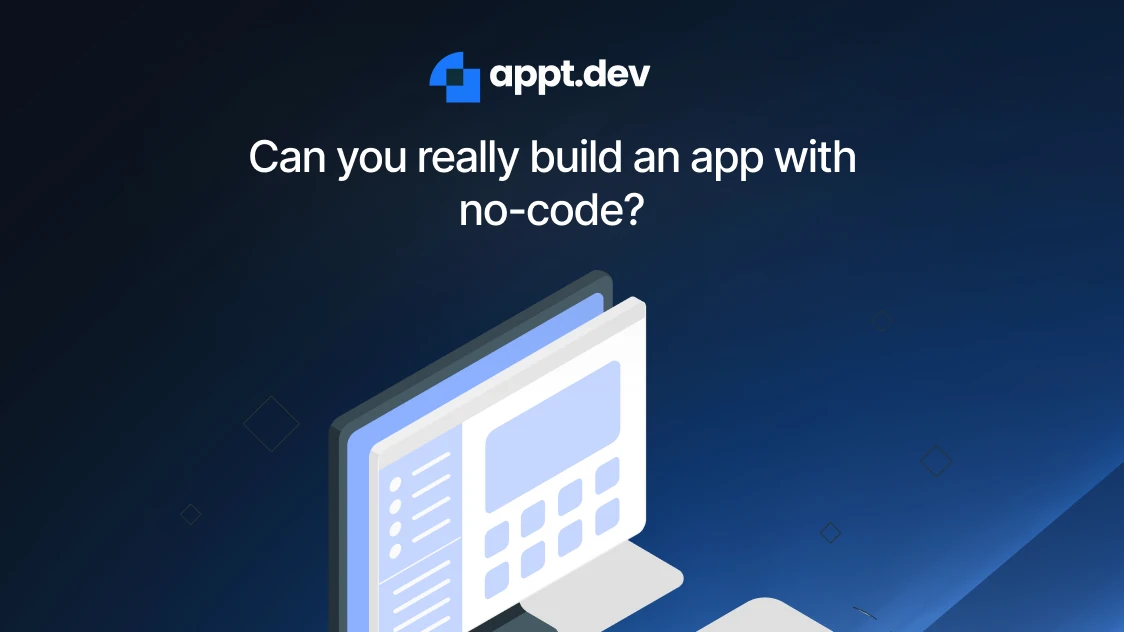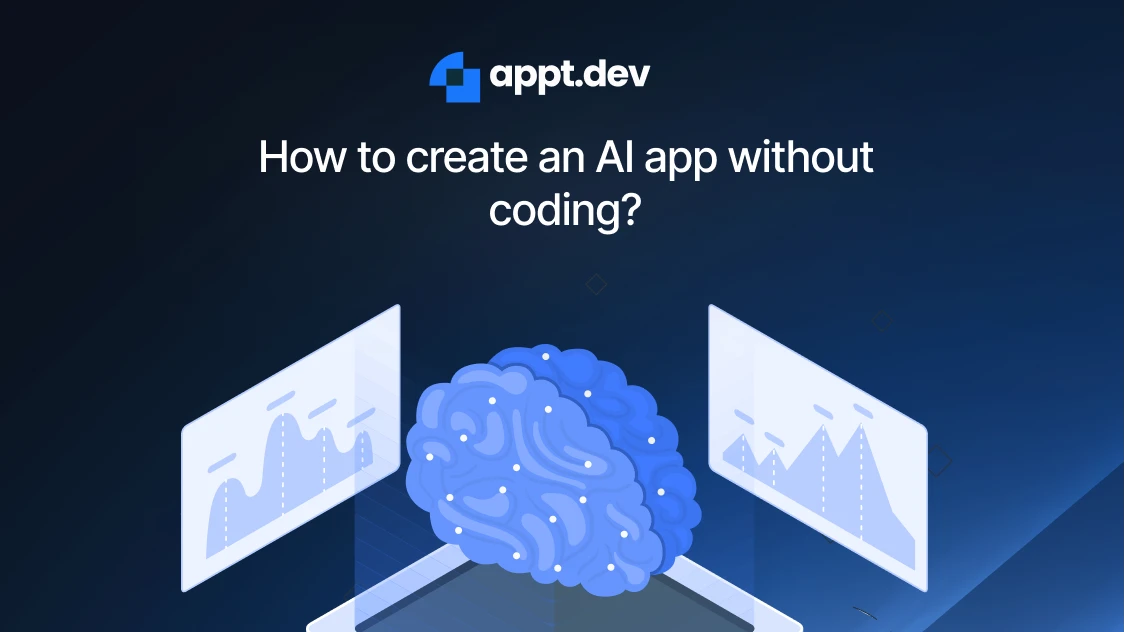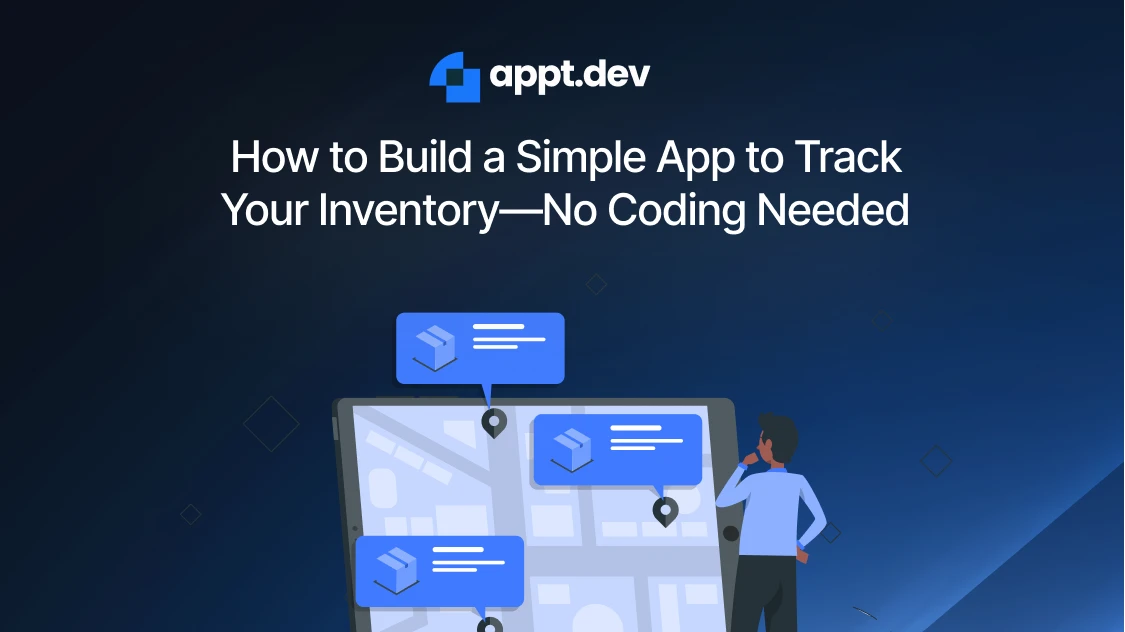AI for Healthcare: Transforming Patient Care with ApptDev
AI for Healthcare

Abhijeet Chowdhury
April 25, 2025 | 4 min
Share to

Healthcare today is confronted with unprecedented challenges. Rapid changes in medical technology, increasing complexity of patient care processes, and mounting regulatory pressures demand that healthcare providers continuously improve efficiency, quality, and responsiveness. With technologies such as artificial intelligence (AI), the Internet of Things (IoT), and advanced robotics evolving rapidly, healthcare organizations are turning to digital solutions to gain a competitive edge. Among these, low‑code platforms have emerged as a powerful tool—enabling production‑ready app development in hours rather than months. ApptDev’s AI‑powered low‑code platform is designed specifically to address healthcare’s pain points by bridging the gap between clinical operations and IT through rapid application development. And the best part? Every solution described here is built with ApptDev.
The Modern Healthcare Challenge
The healthcare landscape is evolving rapidly due to several factors:
- Manual Processes and Data Silos: Traditional healthcare relies heavily on manual data collection, paper‑based patient records, and isolated systems. This increases the risk of errors, delays clinical decision‑making, and hampers real‑time access to vital patient data.
- Quality of Care and Diagnostic Delays: Delays in diagnosis or treatment inconsistencies can lead to adverse outcomes. Many providers struggle to detect critical issues early, resulting in prolonged hospital stays and elevated costs.
- Complex Patient Data Management: With a growing volume of data—from electronic health records (EHRs) to real‑time monitoring via wearable devices—healthcare systems face challenges in integrating and interpreting information, sometimes leading to misdiagnoses.
- Integration of Advanced Technologies: Technologies such as telemedicine, remote monitoring, and AI‑driven analytics are essential for maintaining high‑quality care. Yet, uniting these diverse systems into a unified process can be daunting.
- Workforce Training and Skill Gaps: As digital tools become integral to patient care, upskilling frontline healthcare workers and administrators is increasingly necessary. Many traditional systems require extensive technical know‑how, creating barriers for non‑technical staff.
How ApptDev Solves It:ApptDev’s low‑code platform empowers healthcare teams to build agile, scalable, and user‑friendly software solutions that integrate clinical operations with IT. By eliminating the need for extensive coding, ApptDev enables healthcare providers to address these challenges quickly and efficiently.
Enhancing Clinical Documentation and Diagnostic Accuracy
Manual data entry and fragmented documentation processes often lead to errors and delays in both clinical records and diagnostic reporting. These discrepancies can compromise patient safety, lead to misdiagnoses, and hinder timely treatment.
How ApptDev Empowers Clinical Teams:
- Streamlined Digital Documentation: Replace paper‑based forms and manual logs with interactive digital forms that automatically capture patient data as care protocols are followed. This reduces errors and ensures real‑time documentation.
- AI‑Enhanced Diagnostic Workflows: Integrate AI‑driven analytics to cross‑verify clinical documentation with diagnostic imaging results, flagging discrepancies early and improving the accuracy of patient records.
Example in Action:A healthcare provider can use ApptDev to build an application that logs patient vital signs on a set schedule. By integrating sensor APIs with digital data entry forms, the app stores data in a centralized database and generates real‑time reports—ensuring continuous monitoring and timely interventions.
Enabling Real‑Time Clinical Decision Support
In dynamic clinical settings, delays in accessing real‑time data can prevent healthcare teams from responding swiftly to changes in patient conditions. Without immediate insights, critical decisions may be delayed, adversely affecting patient outcomes.
How ApptDev Enhances Real‑Time Monitoring:
- Dynamic Clinical Dashboards: Develop real‑time dashboards that pull data from IoT sensors and EHR systems, displaying key performance indicators (KPIs) such as patient wait times, bed occupancy, and lab turnaround times. These dashboards provide up‑to‑the‑minute insights for rapid decision‑making.
- Automated Alert Systems: Configure automated triggers that send alerts when specific thresholds are crossed—such as abnormal vital signs—so that care teams can immediately respond to emerging critical situations.
Example in Action:A healthcare provider can use ApptDev to build an application that continuously monitors patient flow in the emergency department. When data indicates a spike in wait times, the system can automatically alert administrators to deploy additional staff or open new treatment areas, ensuring swift adjustments in patient care.
Advancing Personalized Care Through Integrated Data
Healthcare providers often struggle to integrate diverse data sources—from EHRs and genomics to wearable device outputs—resulting in fragmented patient profiles. This lack of a unified view can impede the development of tailored treatment plans.
How ApptDev Supports Personalized Care:
- Unified Patient Profiles: Create applications that merge data from various sources into a comprehensive, easily accessible patient profile. This holistic view enables more precise diagnoses and personalized treatment planning.
- Customizable Care Modules: Utilize the flexibility of ApptDev’s low‑code platform to rapidly build and customize treatment modules based on individual patient data, ensuring care plans are both unique and adaptive.
Example in Action:A healthcare organization can use ApptDev to build an app that aggregates data from EHRs, genetic testing, and remote monitoring devices. The unified patient profiles generated by the app allow clinicians to tailor treatment plans effectively, reducing readmission rates and improving overall outcomes.
Revolutionizing Remote Patient Monitoring and Mental Health Support
Continuous patient care is often limited by traditional monitoring systems that fail to provide real‑time data, and mental health services that are inaccessible outside conventional hours. These gaps can delay interventions and increase stress for patients and providers alike.
How ApptDev Enables Extended Care Solutions:
- Remote Monitoring Systems: Build applications that continuously track critical patient metrics—such as blood pressure, heart rate, and blood glucose—in real time. This allows for early detection of complications and proactive interventions.
- Digital Mental Health Platforms: Develop AI‑powered chatbots and conversational agents that offer 24/7 mental health support, providing immediate assistance and triaging patients who need further professional help.
Example in Action:A healthcare provider can use ApptDev to develop an RPM application to monitor chronic patients while integrating a mental health chatbot for round‑the‑clock support. This dual‑approach not only reduces emergency admissions but also provides continuous care, enhancing overall patient well‑being.
Boosting Operational Efficiency and Reducing Administrative Burdens
The Problem:Inefficient administrative processes, such as manual scheduling, billing, and data entry, burden healthcare staff and divert valuable time away from patient care. This not only increases operational costs but also contributes to clinician burnout.
How ApptDev Optimizes Administrative Workflows:
- Automated Scheduling and Billing: Develop applications that streamline routine administrative tasks, reducing the need for manual intervention and minimizing errors.
- Resource Optimization Tools: Leverage predictive analytics to optimize staffing, inventory management, and other operational resources—ensuring smoother, more efficient healthcare delivery.
Example in Action:A healthcare organization can use ApptDev to create a suite of administrative applications that automate appointment scheduling and billing processes. The enhanced workflows reduce manual workload and help mitigate clinician burnout.
Bridging the Technical Gap and Empowering Healthcare Teams
Many healthcare professionals and administrators lack the technical skills required to develop traditional software solutions, creating a heavy reliance on IT departments. This skills gap can slow innovation and hinder the rapid deployment of essential digital tools.
How ApptDev Empowers Citizen Developers:
- User‑Friendly Interface: ApptDev’s intuitive, drag‑and‑drop platform enables non‑technical users—such as clinicians, nurses, and administrators—to create custom applications without needing extensive programming expertise.
- Comprehensive Training and Support: Detailed guides, tutorials, and responsive support help users quickly become proficient in building and deploying their own applications.
- Built‑in Security and Compliance: With robust security protocols and compliance features, ApptDev ensures that even citizen-developed apps adhere to strict healthcare standards.
Example in Action:A healthcare provider can use ApptDev to empower frontline staff to build a training module app that provides interactive, step‑by‑step instructions on new procedures. This approach enables non‑technical users to develop tools that enhance both patient care and operational efficiency.
Advanced Technical Features of ApptDev
To address the diverse needs of the healthcare sector, ApptDev offers a suite of advanced technical features that streamline the entire application development lifecycle—all built directly within the platform.
The Three‑Step Development Process
Define:
- Capture Requirements: Start by answering guided questions that capture your app’s clinical and operational needs, ensuring alignment with your healthcare goals.
- Specification Framework: The platform automatically generates a detailed blueprint that serves as the foundation for your application.
Develop:
- Intuitive Visual Builder: Use ApptDev’s drag‑and‑drop builder to design user interfaces, integrate AI modules, and configure clinical workflows. Convert design prototypes into fully functional applications with minimal coding effort.
- Healthcare‑Tailored Component Library: Access a rich library of pre‑built components—ranging from digital forms and timers to data connectors and alert systems—that can be customized for healthcare applications.
Deploy:
- One‑Click Deployment: Launch your application instantly using pre‑configured deployment pipelines, ensuring your solution is production‑ready without delays.
- Scalable Infrastructure: Benefit from built‑in infrastructure management that scales with your healthcare operations, whether during peak patient hours or quieter periods.
Infrastructure Builder and API Management
Scalable Digital Infrastructure:
Simplify the creation and management of robust digital systems. Scale resources up or down as needed, ensuring that your applications perform optimally under varying loads.
API Generator:
Easily connect your custom apps to third‑party systems—such as EHRs, inventory management, and legacy software—ensuring a unified and integrated healthcare ecosystem.
Speed to Value:
Dramatically reduce development time and achieve a faster return on investment (ROI) through rapid prototyping and immediate deployment. AI Integration and Advanced
AI Chatbots and Machine Learning:
Build and deploy AI models for predictive patient analytics, automated triage, and intelligent data analysis. ApptDev’s integrations with leading AI tools ensure your applications evolve alongside clinical needs.
Real‑Time Analytics:
Monitor key performance indicators, analyze patient trends, and make data‑driven decisions in real time—critical for continuous improvement in patient care.
LLMOps and Flow Designer:
For advanced scenarios, leverage features like Large Language Model Operations (LLMOps) and a dedicated flow designer to create complex, AI‑driven workflows without leaving the ApptDev ecosystem.
Industry Trends and the Future of Healthcare
The healthcare industry is undergoing rapid transformation, with growing investments in AI and digital technologies. Yet, keeping pace with regulatory changes and technological advancements remains challenging.
How ApptDev Prepares You for Tomorrow:
Embracing Digital Transformation:
In today’s dynamic market, rapid iteration is essential. Low‑code platforms like ApptDev empower healthcare organizations to continuously refine and enhance their applications based on real‑time feedback.
Integration of Emerging Technologies:
Future trends such as generative AI, advanced remote monitoring, and enhanced IoT connectivity are being seamlessly incorporated into ApptDev, ensuring that your solutions remain state‑of‑the‑art.
ROI and Efficiency:
By dramatically reducing development cycles and streamlining deployment, ApptDev drives measurable improvements in operational efficiency, patient care quality, and cost savings. A healthcare organization can use ApptDev to develop a predictive analytics application that reduces emergency response times by up to 30% and significantly improves patient outcomes, while also streamlining administrative processes.
Conclusion: Transforming Healthcare with ApptDev
In a world where every moment can impact patient outcomes, healthcare providers must adopt tools that empower them to respond swiftly and efficiently. ApptDev’s AI‑powered low‑code platform offers a comprehensive solution that directly addresses the core challenges of modern healthcare:
Automating Routine Tasks:
Replace manual, error‑prone processes with digital workflows built effortlessly in ApptDev.
Real‑Time Adjustments:
Create dynamic dashboards and automated control systems that adapt patient care in real time.
Predictive Analytics and Quality Control:
Integrate AI to foresee complications, ensure diagnostic accuracy, and enhance patient safety.
Supply Chain Optimization and Technology Integration:
Develop custom tools that synchronize diverse systems—from medical supplies to telehealth—for seamless operations.
Empowering Non‑Technical Users:
Lower the barrier to app development, enabling clinicians and administrators to build practical solutions independently. With ApptDev, healthcare providers can rapidly prototype, deploy, and scale custom applications that enhance patient care, reduce costs, and drive sustainable growth. Whether you’re looking to modernize patient intake, streamline supply chains, or improve predictive analytics, ApptDev provides the tools you need to build, deploy, and manage robust solutions fast.
Every example in this report illustrates that with ApptDev, you can transform theoretical ideas into practical, production‑ready applications. By leveraging its intuitive design, robust AI integration, and enterprise‑grade scalability, ApptDev isn’t just another tool—it’s the strategic enabler your healthcare operations need to thrive in an increasingly competitive landscape.Discover how you can revolutionize patient care and empower your workforce by building your next custom application entirely within ApptDev.
For more details and to explore how you can start building your own healthcare solutions, visit ApptDev.
References
FAQs
Related Blogs

Can you really build an app with no-code?
In a world where digital transformation is no longer optional, the ability to create custom applications quickly has become a competitive advantage.
Read More
How to create an AI app without coding?
In today's rapidly evolving technological landscape, artificial intelligence has transformed from an exclusive domain of specialized developers to an accessible tool for businesses and individuals alike.
Read More
How to Build a Simple App to Track Your Inventory—No Coding Needed
Here’s a concise guide to building a custom inventory-tracking app on ApptDev—no coding required. You’ll learn why inventory management matters, how ApptDev’s visual tools streamline every step, and key insights to maximize efficiency. By following our six-step walkthrough, you’ll go from blank canvas to deployed app in under an hour, complete with automated reorder alerts and mobile-ready interfaces.
Read More